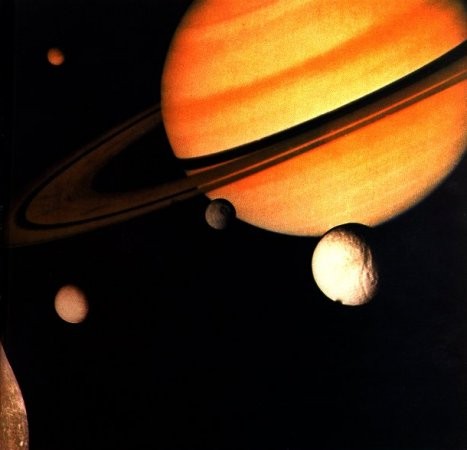Watch the Skies for Mars, Jupiter and Saturn and Their Moons This June
| Ana Verayo | | Jun 06, 2016 09:32 AM EDT |
(Photo : NASA) Montage taken from NASA's Voyager 1 spacecraft of Saturn and its moons.
This June, the solar system will be gracing the night skies featuring some of the major planets that can become visible to the naked eye which includes Mars, Jupiter and Saturn. Astronomers consider this as a "celestial extravaganza" and also for amateur astronomers and sky watchers as well, which will include the moons of Saturn and Jupiter as well.
Like Us on Facebook
These three planets can be observed between June 1 to the 30th after the sun sets, where Jupiter will now become visible in the western skies throughout the evening which is located to the left of the moon, according to NASA. Apart from this, Jupiter and its four moons will also be visible however, to spot the Galilean moons, Io, Europa, Ganymede and Calisto, binoculars and telescopes are required for watchers where they will be all lined up in a perpendicular manner to the solar system's biggest planet.
In the meantime, Mars will be in opposition to Earth which means that this will become the closest approach to our planet which occurred on May 30. Into the whole month of June, Mars will begin to slowly fade away as it goes farther away from Earth from its orbit, where Saturn now has the chance to be brighter than the Red Planet this month.
According to NASA Jet Propulsion Laboratory's Jane Johnson, when Saturn reaches opposition, Saturn, Earth and the sun will now be aligned in a straight line, where our planet will be directly in between of Saturn and the sun. This strategic position can provide the best close-up views of Saturn along with seven of its moons.
Saturn will appear to have a creamy, brown color as it becomes brighter in the night skies. Upon using a telescope, Saturn will be able to reveal its rings with some details as well. The Cassini Division which is the gap between the rings of Saturn can also be observed using a telescope where this is named after NASA's Saturn probe Cassini and astronomer Giovanni Domenico Cassini who discovered Saturn.
Among Saturn's moons that can be viewed via telescope is Titan, which is estimated to be twice as big as our own natural satellite. Fortunately, this parade of planets are visible anywhere in the world which also includes the comet PanStarrs, according to NASA.
Tagssolar system, mars jupiter saturn, Astronomy, june skies 2016, mars jupiter saturn moons june 2016, june 2016 night skies
©2015 Chinatopix All rights reserved. Do not reproduce without permission
EDITOR'S PICKS
-

Did the Trump administration just announce plans for a trade war with ‘hostile’ China and Russia?
-

US Senate passes Taiwan travel bill slammed by China
-

As Yan Sihong’s family grieves, here are other Chinese students who went missing abroad. Some have never been found
-

Beijing blasts Western critics who ‘smear China’ with the term sharp power
-

China Envoy Seeks to Defuse Tensions With U.S. as a Trade War Brews
-

Singapore's Deputy PM Provides Bitcoin Vote of Confidence Amid China's Blanket Bans
-

China warns investors over risks in overseas virtual currency trading
-

Chinese government most trustworthy: survey
-

Kashima Antlers On Course For Back-To-Back Titles
MOST POPULAR
LATEST NEWS
Zhou Yongkang: China's Former Security Chief Sentenced to Life in Prison

China's former Chief of the Ministry of Public Security, Zhou Yongkang, has been given a life sentence after he was found guilty of abusing his office, bribery and deliberately ... Full Article
TRENDING STORY

China Pork Prices Expected to Stabilize As The Supplies Recover

Elephone P9000 Smartphone is now on Sale on Amazon India

There's a Big Chance Cliffhangers Won't Still Be Resolved When Grey's Anatomy Season 13 Returns

Supreme Court Ruled on Samsung vs Apple Dispute for Patent Infringement

Microsoft Surface Pro 5 Rumors and Release Date: What is the Latest?










